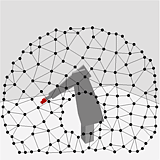Research Topics - Neurobiology
Concerned with both central and peripheral nervous system in living organisms, the field of neurobiology includes explorations into the structure, function, development, biochemistry, physiology and pathology of the nervous system, with the level of analysis ranging from molecular through cellular levels of analysis. At the Theoretical and Computational Biophysics Group, research topics have included the use of neural networks to control motor movement, including visuo-motor control (based on models of the visual cortex and studies of its development) and applicability of neural network concepts to control robotic arms.
After the topology preserving map of a given input manifold M has been established, we want to generate a path from any initial position to a given target, e.g., to guide an end effector of a robot manipulator in the presence of obstacles within the workspace. We propose to use for this purpose a diffusion-based path finding algorithm on the discrete network lattice in which the target neuron is the source of a diffusing substance.
Papers
Noise-induced neuronal oscillations. Christian Kurrer and Klaus Schulten. Physical Review E, 51:6213-6218, 1995.
Models of orientation and ocular dominance columns in the visual cortex: A critical comparison. Edgar Erwin, Klaus Obermayer, and Klaus Schulten. Neural Computation, 7:425-468, 1995.
Topology representing network in robotics. Kakali Sarkar and Klaus Schulten. In J. Leo van Hemmen, Eytan Domany, and Klaus Schulten, editors, Models of Neural Networks, volume 3 of Physics of Neural Networks, pp. 281-302. Springer-Verlag, New York, 1996.
Topology representing networks. Thomas Martinetz and Klaus Schulten. Neural Networks, 7:507-522, 1994.
Neural network control of a pneumatic robot arm. Ted Hesselroth, Kakali Sarkar, P. Patrick van der Smagt, and Klaus Schulten. IEEE Transactions on Systems, Man, and Cybernetics, 24:28-37, 1994.
Statistical-mechanical analysis of self-organization and pattern formation during the development of visual maps. Klaus Obermayer, Gary G. Blasdel, and Klaus Schulten. Physical Review A, 45:7568-7589, 1992.
Textbook: Neural Computation and Self-Organizing Maps: An Introduction. Helge Ritter, Thomas Martinetz, and Klaus Schulten. Addison-Wesley, New York, revised English edition, 1992.
"Neural gas" for vector quantization and its application to time-series prediction. Thomas M. Martinetz, Stanislav G. Berkovich, and Klaus Schulten. IEEE Transactions on Neural Networks, 4:558-569, 1993.
A principle for the formation of the spatial structure of cortical feature maps. Klaus Obermayer, Helge Ritter, and Klaus Schulten. Proceedings of the National Academy of Sciences, USA, 87:8345-8349, 1990.
Development of feature detectors by self-organization: A network model. Jeanne Rubner and Klaus Schulten. Biological Cybernetics, 62:193-199, 1990.
Three-dimensional neural net for learning visuo-motor coordination of a robot arm. Thomas Martinetz, Helge Ritter, and Klaus Schulten. IEEE Transactions on Neural Networks, 1:131-136, 1990.
Topology-conserving maps for learning visuo-motor-coordination. Helge Ritter, Thomas Martinetz, and Klaus Schulten. Neural Networks, 2:159-168, 1989.
Associative memory with high information content. Joachim Buhmann, Robert Divko, and Klaus Schulten. Physical Review A, 39:2689-2692, 1989.
Convergence properties of Kohonen's topology conserving maps: Fluctuations, stability and dimension selection. Helge Ritter and Klaus Schulten. Biological Cybernetics, 60:59-71, 1988.




